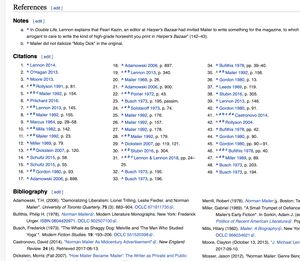Wikipedia Sourcing

First off: there are several ways to add references, or source, on Wikipedia, yet some are more elegant than others. One of the best approaches for sourcing — especially when writing in an academic way — is to use the combination of a bibliography (or Works Cited) and shortened footnotes, or Harvard citations. Because we will often cite a source more than once, this approach makes the most logical sense. If you are remediating an article for The Mailer Review, then you will be using this combination. Here’s how we do it.
First off, have a look at an example: “The Man Who Studied Yoga” is an article that I (mostly) wrote. If you scroll to the bottom, you’ll see the references section contains three subsections: Notes, Citations, and Bibliography.[1] Let’s start with the latter.
In order to use these codes, you should not use the visual editor on Wikipedia, LitWiki, or Project Mailer. Instead, select “Edit Source” to see and use all the codes I mention below.
Bibliography
This section contains all of your references in alphabetical order by the author’s last name. This is easier for two reasons: (1) you only need to list the reference once in the article, and (2) it cleans up your body text of much of the confusing code.[2] This section is created like this:
====Bibliography====
{{Refbegin}}
* {{cite book |last= |first= |date= |title= |url= |location= |publisher= |pages= |isbn= |author-link= |ref=harv }}
* {{cite journal |last= |first= |title= |url= |journal= |volume= |issue= |date= |pages= |access-date= |ref=harv }}
* {{cite magazine |last= |first= |date= |title= |url= |magazine= |pages= |access-date= |ref=harv }}
* {{cite news |last= |first= |date= |title= |url= |work= |location= |access-date= |ref=harv }}
* {{cite web |url= |title= |last= |first= |date= |website= |publisher= |access-date= |quote= |ref=harv }}
{{Refend}}
This might look a bit confusing, but I’ll go through it. The first line adds a subsection. I used a sub-subsection (four ====) but you can use whatever is appropriate and logical.
All references should appear between {{Refbegin}} and {{Refend}} in a bulleted list (notice each reference is on its own line and begins with *.
I have given you the codes I use for the main types of references you will likely need, from best to least best: book, journal, magazine, newspaper, and web site.[3] Notice many of the codes contain similar elements, but one in particular must be used for this technique to work: ref=harv — I usually put this at the end.[4] This code for the Harvard citation and points a shortened footnote to the detailed bibliographic entry.
Shortened Footnotes
The shortened footnote {{sfn}} may now be used in the body of the article to cite a source. First, add a section where your citations will appear, just above your bibliography:
====Citations====
{{Reflist}}
Here’s an example of the shortened footnote at work in the body of the article:
This novella was first published in ''New Short Novels 2'', 1956.{{sfn|Lennon|2018|p=25}}
This is a Wikipedia template. “Sfn” calls the template in the code; the author’s last name follows the first pipe (this must correspond with the name that follows |last= in the detailed citation); the date of the publication follows the next (exactly the same as |date= in the citation); and the page number(s) are put last. This will insert a footnote in the text; when a user clicks it, she is taken to the citation and if she clicks the citation, she is taken to the bibliographic entry. Try it on the example article I linked above. Simple and elegant.
See the link to the shortened footnote template for other options.
Explanatory Footnotes
The final section is for explanatory footnotes {{efn}}. This is not a required or even necessary section, unless you need it. In fact, don’t even include it if you have no explanatory footnotes. You can often use it in combination with the shortened footnote to make a complex and detailed reference section.
If you need it, add a section where your explanatory citations will appear, just above your citations section:
====Notes====
{{Notelist}}
Any explanatory footnotes you add will appear first. Here’s an example of in the text of an article:
{{efn|The rain in Spain stays mainly on the plain.}}
The note would appear like this.[a]

Refer to the links for more explanation about this method.
All Together
See an example of a complete references section on “The Man Who Studied Yoga.” If you click the “Edit” tab, you can scroll to the bottom to see how all the coded elements works, including details that this article did not touch on. In fact, the best way to learn to edit is by looking at the code of a page you’d like to emulate and just copying the code.
notes & references
- ↑ The rain in Spain stays mainly on the plain.
- ↑ Remember, you can always click “Edit” to see how each of these sections is formatted. I’ll explain, but often the best way to learn is to see how it work in a real situation.
- ↑ Not to mention, you needn’t remember what name you gave a reference if you used it before.
- ↑ All citation codes and explanation for the variables may be found on “Citation Templates.” Not sure what your reference is? Try Googling it or ask me.
- ↑ This is no longer necessary for Wikipedia, but it is for Project Mailer.
